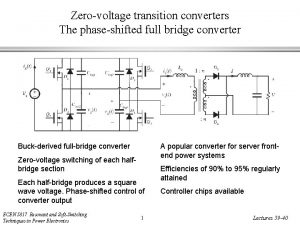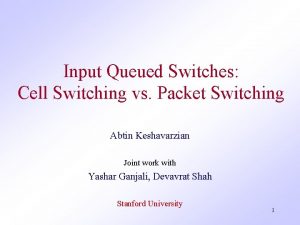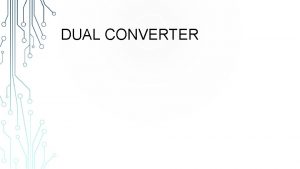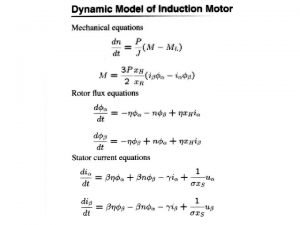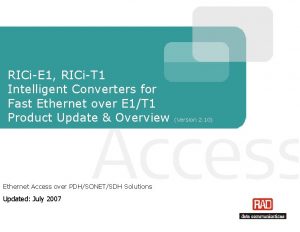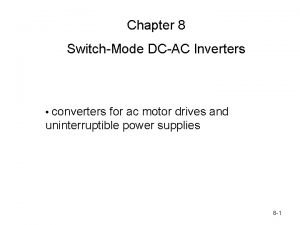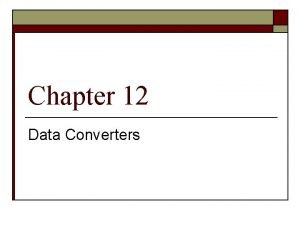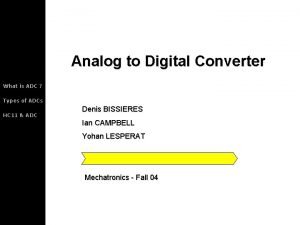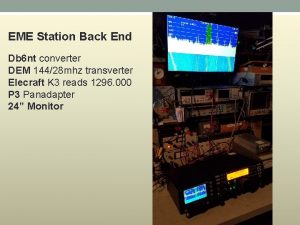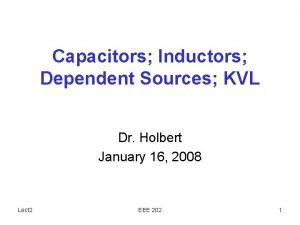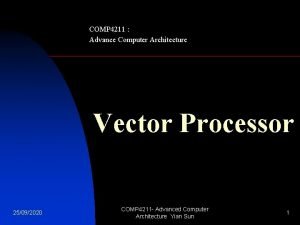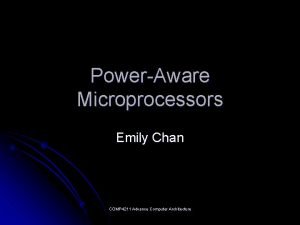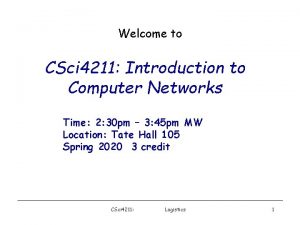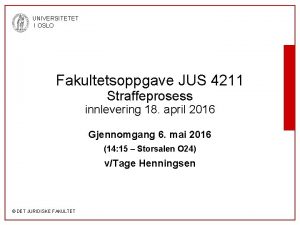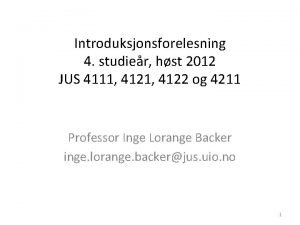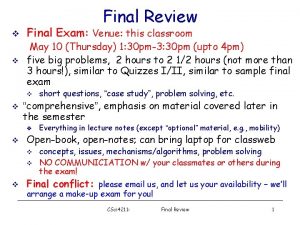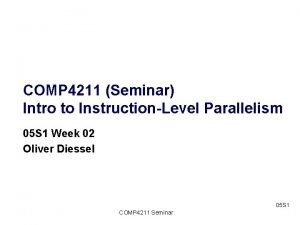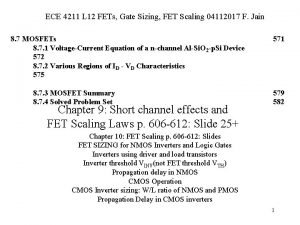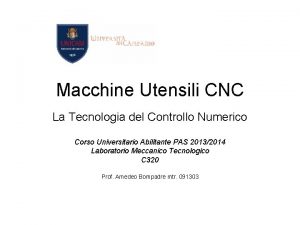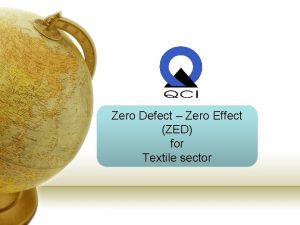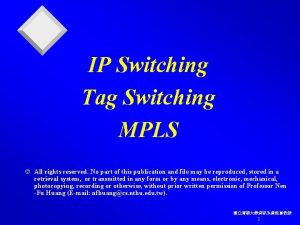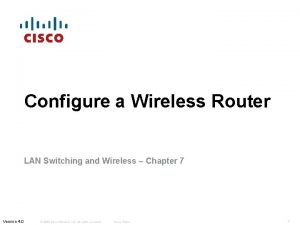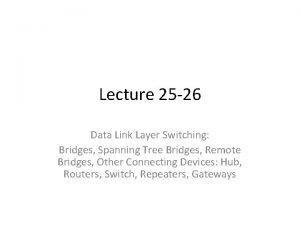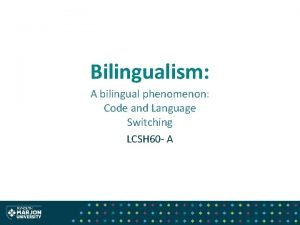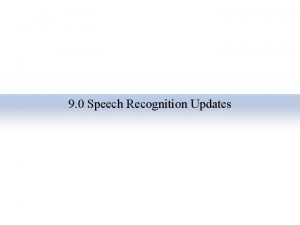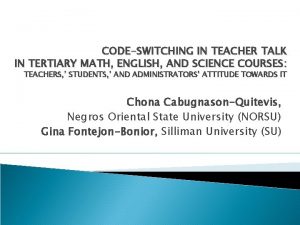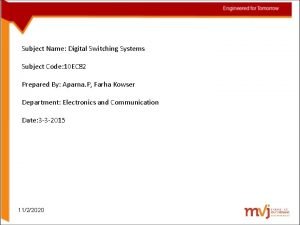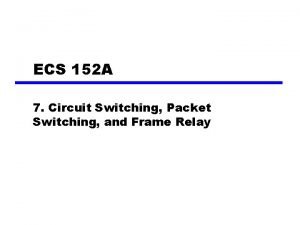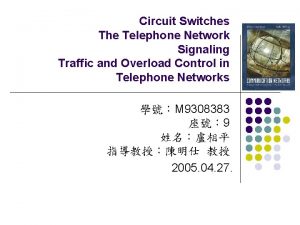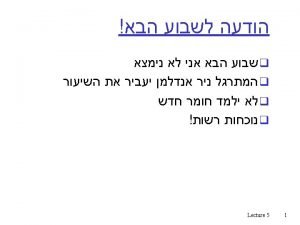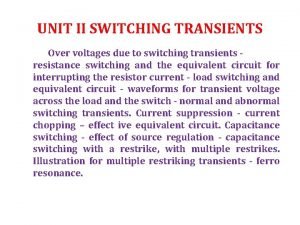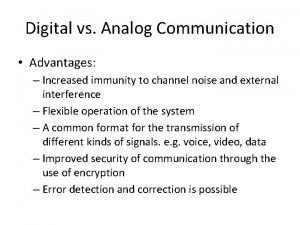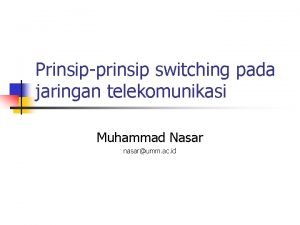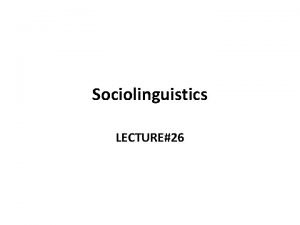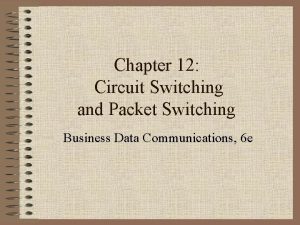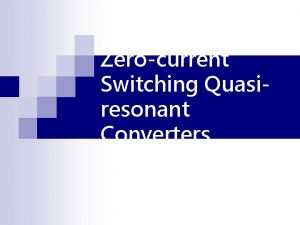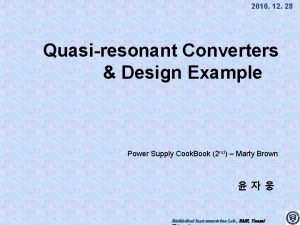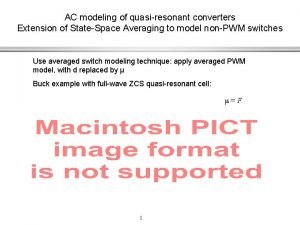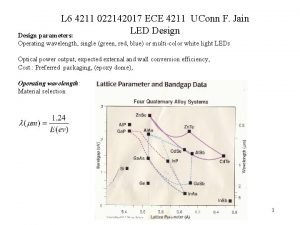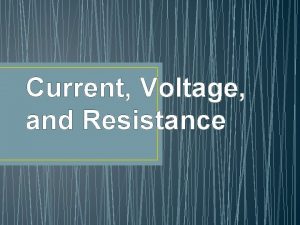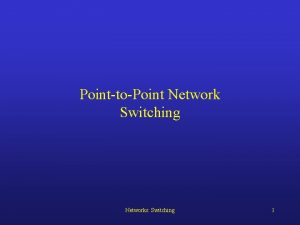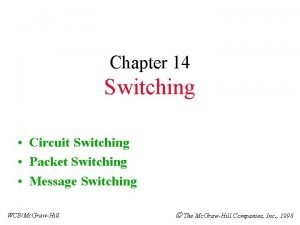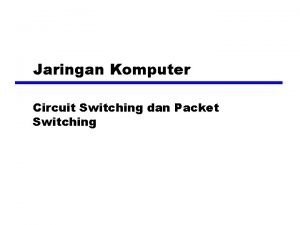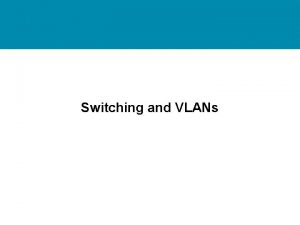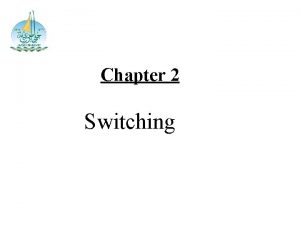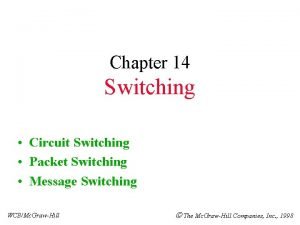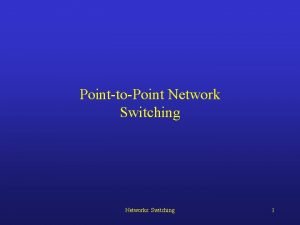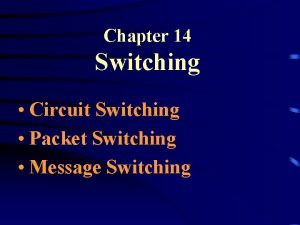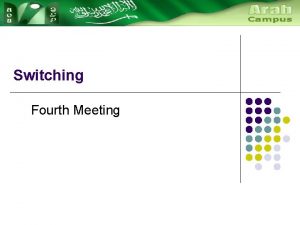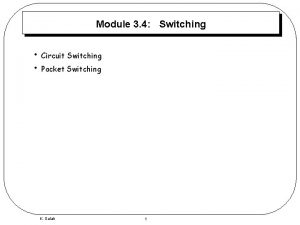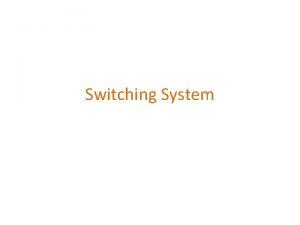Zero Voltage Switching Quasiresonant Converters EE 4211 1




















































- Slides: 52

Zero Voltage Switching Quasi-resonant Converters EE 4211 1

Introduction Zero-current switching is not true softswitching It does have loss in the junction capacitor For example, a switching device is operating under device voltage Vsw 300 V DC and the switching frequency is 1 MHz. The junction capacitance Cj is 500 p. F. The loss is then: The loss is very high An alternative method to cure this problem is to use zero-voltage switching. EE 4211 2

Resonant switches Zero –current switch EE 4211 Zero-voltage 3

Configurations of the zerovoltage switch general half-wave EE 4211 full-wave 4

Zero voltage switching Quasiresonant (ZVS-QR) Buck converter LF and CF, are large The analysis can be simplified by assuming the current through the bulk inductor is a current sink. EE 4211 5

4 stages of operation Capacitor charging stages: (Fig. 4 a) Resonant state: (Fig. 4 b) Inductor recovering stage (Fig. 4 c) Free-wheeling stage: (Fig 4 d) EE 4211 6

Equivalent circuit EE 4211 7

Capacitor charging stages Switch SW is turned off at t 0. Input current i. Lr rises linearly and is governed by the state equations Solution: EE 4211 8

Half-wave Uni-directional of resonant voltage on Vc EE 4211 9

Full-wave Bi-directional voltage on Vc EE 4211 10

Boundary condition and Duration The stage will finish when v. Cr increases to Vin, the voltage across DF becomes positive and it is in forward bias. The duration of this state Td 1 =Cr Vin / Io Boundary condition: v. Cr =Vin EE 4211 11

Resonant state: Lr and Cr resonate and DF is on The solution is: Resonant frequency Impedance EE 4211 12

Duration and Boundary Finish when the resonant capacitor voltage v. Cr reaches zero. The duration of this state Td 2 is EE 4211 13

Termination of resonant stage The termination of this state is similar to the zerocurrent switching. For the half-wave mode, when resonant voltage v. Cr reaches zero, it cannot be reversed because the anti-parallel diode D of the switch conducts. The transistor T of the switch SW can be turned on after that to achieve zero-voltage switching. For full-wave mode, v. Cr can reverse into negative because there is a series diode D with the transistor T. During v. Cr is negative, the transistor T should be turned off. When v. Cr resonates back from negative to zero, since T is EE 4211 stops. 14 already off, the resonance

Voltage during the end of stage At t 2, i. Lr = Iocos EE 4211 15

Inductor recovering stage: Resonance stops, Lr begins to be charged by the input voltage Vin The solution: EE 4211 16

Finish of this stage Finish when i. Lr reaches the value of output current IO. DF no longer conducts because its current is now all conducted by Lr. Duration: Td 3 = Lr Io cos / Vin Boundary condition: i. Lr=Io EE 4211 17

Free-wheeling stage: (Fig 4 d) Output current freewheels through Lr and switch SW. This stage finishes when the transistor turns off again at t 4 is the same as t 0 in next cycle. Duration: Td 4= Ts-Td 1 -Td 2 -Td 3 where Ts is the period of the switching cycle. EE 4211 18

Zero-voltage switching condition The AC component of the resonant voltage is required to be greater than its DC level in order to achieve the ZVS. In this case, the condition is: This condition is the same as (12): EE 4211 19

Zero-voltage switching When to turn on and off The instant to turn on the switch is also important. For half-wave mode, the transistor must be turned on after v. Cr reaches zero at t 2 and before isw increases back to positive. For full-wave mode, the transistor must be turned on when v. Cr is negative. When T is turned on, the series diode D is still in reverse bias and the voltage across T is virtually zero. EE 4211 20

Why full-wave is no good The charge stored in the junction capacitor of T cannot be conducted to outside, therefore when T is turned on this energy is dissipated internally. Therefore the switching loss is not zero. The current i. SW through either T or D during t 2 -t 4 is annotated in Fig. 5. EE 4211 21

DC voltage conversion The output voltage Vo can be solved by equating the input energy Ein and output energy Eo EE 4211 22

DC voltage conversion(Half-wave) Still varies between 0 and 1 which is a generally characteristic of Buck converters. The ratio now decreases with fs/fo increasing Depends on the load resistance R EE 4211 23

DC voltage conversion(Half-wave) Still varies between 0 and 1 which is a generally characteristic of Buck converters. The ratio now decreases with fs/fo increasing Independent of the load resistance R EE 4211 24

Zero voltage switching Quasiresonant Boost converter A steady-state equivalent circuit using a current source Iin which represents the input current. EE 4211 25

Equivalent circuit EE 4211 26

4 stages of operation Capacitor charging stages: (Fig. 8 a) Resonant state: (Fig. 8 b) Inductor recovering stage (Fig. 8 c) Free-wheeling stage: (Fig 8 d) EE 4211 27

Half-wave Uni-directional of VCr Similar to ZCS but the shapes of i. Lr and Vcr are swapped. EE 4211 28

Full-wave Bi-directional of VCr Similar to ZCS but the shapes of i. Lr and Vcr are swapped. EE 4211 29

Capacitor charging stage Resonant capacitor voltage v. Cr rises linearly due to the input current and is governed by the state equations: Solution: EE 4211 30

Termination of stage 1 When v. Cr increases to the value of Vo, DF becomes forward biased. The duration of this state: Td 1 =Cr Vo / Iin Boundary condition: v. Cr =Vo EE 4211 31

Resonant state Lr and Cr resonate and DF is on The solution is: The definition of o and Z is the same EE 4211 32

Termination of this stage This stage finishes when the resonant capacitor voltage reaches zero. For half-wave mode, the anti-parallel diode D of the switch SW conducts. The resonant voltage across SW cannot be reversed. For full-wave mode, the transistor T of the SW should be turned off when the resonant voltage across the switch is negative. At this time, the series diode D is in reverse bias and T can then be turned off under zero-voltage switching. EE 4211 33

Boundary The duration of this state Td 2 is Boundary condition: EE 4211 v. Cr =0 34

The current left in Lr At t 2, i. Lr = Iin (1 -cos ) EE 4211 35

Inductor recovering stage (Fig. 8 c): Resonance stops and Lr begins to be discharged through the output voltage. The solution is: EE 4211 36

Boundary of Inductor recovering stage Duration: Td 3 = Lr Iin (1 -cos ) / Vo Boundary condition: EE 4211 i. Lr=0 37

Free-wheeling stage Output current freewheels through switch SW. This stage finishes when the transistor turns off again at t 4. The t 4 is the same as t 0 in the next cycle. Duration: Td 4= Ts-Td 1 -Td 2 -Td 3 EE 4211 38

DC voltage conversion The output voltage Vo can be solved by equating the input energy Ein and output energy Eo. The output current Io for the derivation of the Eo can be obtained from the current of the diode DF that is the same as the i. Lr EE 4211 39

Voltage conversion ratio (halfwave) Depends on Load Minimum is 1 Maximum approaches to infinity EE 4211 40

Voltage conversion ratio (fullwave) Relatively independent of Load Looks like the classical Boost converter characteristics. EE 4211 41

Other converter (Buck-Boost) Can be formed similarly as the other two converters Also inverted output voltage EE 4211 42

Equivalent circuit EE 4211 43

Voltage conversion ratio Half-wave Full-wave EE 4211 44

Correct Full-wave for Buck-Boost The previous is correct because: Does not cover Vo/Vin =0 when fs/fo is close to one When fs/fo is 0. 2, the Vo/Vin is too large EE 4211 45

Duration of each stage in ZVS Stage Duration Td 1 Td 2 Td 3 Td 4 Ts-Td 1 -Td 2 Td 3 EE 4211 46

Comparison of Vo/Vin of the classical and QRC Classical ZCS ZVS Buck D g 1 -g Boost Buck. Boost Cuk EE 4211 47

Summary of the quasiresonant ZVS converters Advantage Disadvantage True soft-switching High voltage rating is needed No power loss during switching ZVS Depends on load condition Not good for very high voltage input EE 4211 48

Practical implementation of ZVS quasi-resonant converters Buck Boost Buck-Boost Cuk EE 4211 49

Tutorial A ZVS Quasi-resonant Buck converter is operated under the following condition: 1) Vin=50 V 2) Vo=25 V 3) fs=1 MHz 4) Io=5 A Using the condition of the converter just able to achieve ZVS, suggest the Lr and Cr that is needed. Assume the junction capacitance of the transistor is 100 p. F. EE 4211 50

Answer Full-wave cannot be used because of the junction capacitor of the transistor, therefore Half-wave is used Therefore: for just ZVS, Vin=ZIo => 50=Z*5 =>Z=10 Hence, you can obtain fo=1. 976 MHz EE 4211 51

Answer (Cont) => After calculated Cr, the actual required Cr is to => be deduced by the junction capacitance of the transistor. EE 4211 Actual Cr=8. 05 n. F-100 p. F =7. 95 n. F 52
 Circuit switching packet switching message switching
Circuit switching packet switching message switching Zero voltage switching waveforms
Zero voltage switching waveforms Virtual circuit network and datagram network
Virtual circuit network and datagram network Cell switching vs packet switching
Cell switching vs packet switching Cell switching vs packet switching
Cell switching vs packet switching Difference between circuit message and packet switching
Difference between circuit message and packet switching Packet switching system
Packet switching system Single phase dual converter waveforms
Single phase dual converter waveforms Dcac converters
Dcac converters Intelligent converters
Intelligent converters Under the hood of flyback smps designs
Under the hood of flyback smps designs Unipolar
Unipolar Digital to analog converters basic concepts
Digital to analog converters basic concepts What is adc?
What is adc? Eme converter
Eme converter Catalytic converter reaction
Catalytic converter reaction Difference between phase voltage and line voltage
Difference between phase voltage and line voltage Voltage peak to rms
Voltage peak to rms Low voltage
Low voltage What is the objective of earthing
What is the objective of earthing Control of induction motor by ac voltage controllers
Control of induction motor by ac voltage controllers Kvl with capacitors
Kvl with capacitors Comp 4211
Comp 4211 Comp4211
Comp4211 Csci 4211
Csci 4211 Jus 4211
Jus 4211 Jus 4211
Jus 4211 Csci 4211
Csci 4211 Comp4211
Comp4211 Domsanalyse mønsterbesvarelse
Domsanalyse mønsterbesvarelse Ece 4211
Ece 4211 Zero macchina e zero pezzo
Zero macchina e zero pezzo Zero defect zero effect
Zero defect zero effect Tag switching example
Tag switching example Switching adalah
Switching adalah Data link layer switching
Data link layer switching What is code-switching in language
What is code-switching in language Code switching
Code switching What are the types of code switching
What are the types of code switching Intralm
Intralm Circuit switching in networking
Circuit switching in networking Reactive arrangements external validity
Reactive arrangements external validity Spc switching system overload control
Spc switching system overload control Types of switching
Types of switching Routing and switching
Routing and switching Switching transients are *
Switching transients are * Analog communication
Analog communication Denominational switching
Denominational switching Contoh circuit switching
Contoh circuit switching Code switching in sociolinguistics
Code switching in sociolinguistics Applications of circuit switching
Applications of circuit switching Switching in data link layer
Switching in data link layer Igmpv
Igmpv

